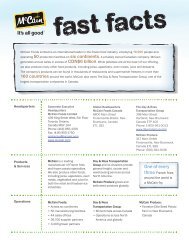From the Ground Up - McCain Foods Limited
From the Ground Up - McCain Foods Limited
From the Ground Up - McCain Foods Limited
Create successful ePaper yourself
Turn your PDF publications into a flip-book with our unique Google optimized e-Paper software.
ABOVE and LEFT: Fire at <strong>the</strong> Florenceville factory, December 31,<br />
1989. BELOW: Firefighter with volunteer firefighter Jim Bushby<br />
(right), of <strong>McCain</strong>.<br />
couldn’t be sold because of smoke damage. But it was<br />
still good to eat, so ninety-three tractor trailer loads<br />
rolled out of Florenceville to deliver it to food banks in<br />
<strong>the</strong> Atlantic provinces, Quebec, and Ontario.<br />
The significance of <strong>the</strong> great fire is in what it revealed<br />
about <strong>the</strong> company and how far it had come since it<br />
first opened for business on that very spot thirty-two<br />
years earlier. Such a fire in <strong>the</strong> early years would have<br />
been a calamity, perhaps closing <strong>McCain</strong> <strong>Foods</strong> down<br />
for good. In 1989, however, <strong>the</strong> partial destruction and<br />
closure of <strong>the</strong> company’s flagship plant was a nuisance<br />
ra<strong>the</strong>r than a disaster. It was merely an unfortunate end<br />
to an excellent year.<br />
In 1989, <strong>McCain</strong> achieved $2 billion in sales for <strong>the</strong><br />
first time in its history. This was a remarkable achievement<br />
considering that <strong>the</strong> company had passed <strong>the</strong><br />
$1 billion mark only four years previously. By reaching<br />
$2 billion in 1989, <strong>McCain</strong> surpassed <strong>the</strong> goals it<br />
had set for itself in 1985 of doubling sales in five years.<br />
Instead, it did it in only four by increasing sales of existing products, developing<br />
new ones, and acquiring o<strong>the</strong>r companies.<br />
In <strong>the</strong> 1980s, Japan was in its heyday as <strong>the</strong> world’s new economic superpower, and<br />
much was written about <strong>the</strong> management style responsible for <strong>the</strong> country’s success.<br />
What it all boiled down to was an obsession with quality. The Japanese knew that <strong>the</strong><br />
way to achieve high quality in manufacturing was through a constant flow of small<br />
improvements in <strong>the</strong> manufacturing process. Over <strong>the</strong> long term, those small improvements<br />
added up to major improvements and higher profits.<br />
<strong>McCain</strong>’s management understood that from <strong>the</strong> beginning. As Wallace <strong>McCain</strong><br />
said in 1989, “At <strong>the</strong> same time that competition is getting tougher, we are more than<br />
meeting <strong>the</strong> challenge by increasing productivity and improving quality on a continuing<br />
basis.” Or, as Harrison liked to say, “If you are standing still, you are going<br />
backwards.”<br />
Only one direction was acceptable: forward. That meant expanding to new territories<br />
and building or buying new production facilities. And it meant constant striving<br />
for improvement in <strong>the</strong> methodology of growing potatoes and processing <strong>the</strong>m.<br />
Morris and Tim Bliss, vice-president of engineering, visited <strong>the</strong> various plants<br />
126 f rom <strong>the</strong> <strong>Ground</strong> up<br />
<strong>the</strong> home front 127<br />
Wallace in <strong>the</strong> lab, surveying<br />
an assortment of <strong>McCain</strong><br />
packaging.






